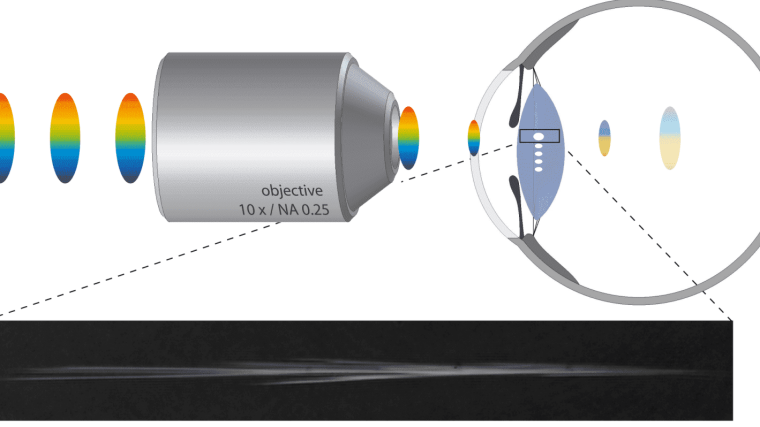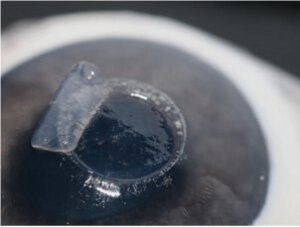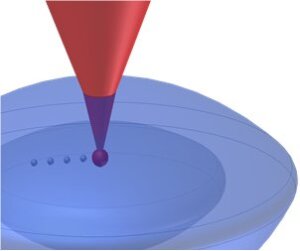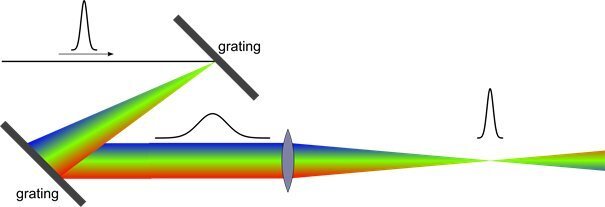
Thin flap of a porcine cornea created with femtosecond laser pulse.
Image: Univ. Jena, IAPThe high intensity of focused ultrashort laser pulses enables various medical applications like precise modification and ablation of tissue. Our research focuses on the interaction of femtosecond laser pulses with transparent tissue, especially for applications in ophthalmology.
When ultrashort laser pulses are focused into transparent material, the high intensity within the focal volume leads to nonlinear absorption. The absorbed energy induces a micro plasma, causing the formation of a micro bubble that separates the tissue in a small region of only several micrometers. By the movement of the laser focus, precise cuts can be realized avoiding the need of opening the eyeball [Graefes Arch. Clin. Exp. Ophthalmol. 249, 1567-1573 (2011)External link].
Scheme of laser induced optical breakdown creating small spots of separated tissue within the crystalline lens.
Illustration: Univ. Jena, IAPNon-invasive femtosecond-laser surgery offers great potential for the modification of transparent tissue and is currently discussed as a possible treatment e.g. for presbyopia [Ophthalmologe 113, 1014-1019 (2006)External link]. Presbyopia, the decreasing ability of the eye to focus at close distance, is mainly caused by the hardening of the crystalline lens with age. Femtosecond laser surgery enables precise cuts within the lens nucleus to soften the tissue. Due to the reduced stiffness, lens flexibility is increased and accommodation can be restored.
Besides the treatment of the lens tissue, fs-laser surgery allows precise opening of the lens capsule (capsulorhexis) to remove clouded lens tissue in case of a cataract. Furthermore, ultrashort laser pulses can be used as a laser scalpel, e.g. to remove a thrombus as a treatment for the apoplectic stroke.
However, when high pulse energies or low numerical apertures are required for the treatment, nonlinear effects such as self-focusing and filamentation may decrease the confinement, and thus, the quality of the laser-induced modifications. This is in particular the case for applications in deeper eye segments, where high pulse energies and low numerical apertures are required. To overcome this, simultaneous spatial and temporal focusing (SSTF) is a tool to induce precise optical breakdown [Proc. SPIE 8611, 86110A (2013)External link]. For SSTF, the spectral components of the incident laser pulse are spatially separated by means of a grating stretcher setup. Due to the reduction in local bandwidth, this separation results in a rainbow-like, collimated beam with increased pulse duration. The entire spectral bandwidth is recovered where the spectral components overlap again, e.g. within the focal volume of a lens. Thus, the ultrashort pulse exists in the focal region only, reducing nonlinear side-effects such as self-focusing and filamentation.
Setup for simultaneous spatial and temporal focusing of an ultrashort laser pulse.
Illustration: Univ. Jena, IAP

